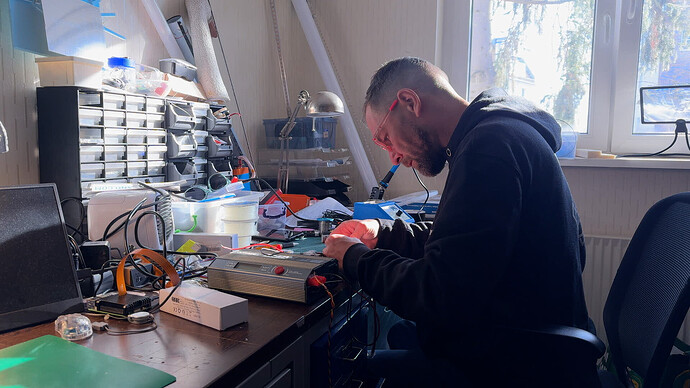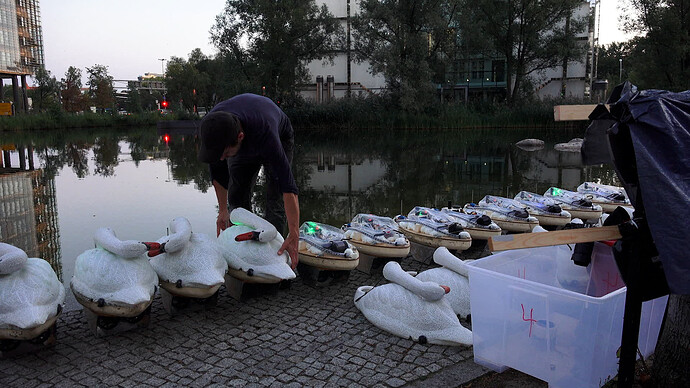Hello! We have a very cool and, perhaps unusual, build for you to check out! Our friends Florian and Denis from Loomaland reached out to see if we could support them in bringing a wild idea to fruition. Our M200s were the perfect match for their project - they needed something reliable, waterproof, and powerful.
Getting the right tools into the hands of the people who needed them resulted in a jaw-dropping flock of illuminated autonomous swans called CYGNUS. Below, the Loomaland team chats about the trials and tribulations involved in bringing art and robotics together in a truly breathtaking way.
BLUE ROBOTICS: What was the most challenging task when bringing this project to life?
LOOMALAND: In building the swans, the moving heads turned out to be one of the most challenging parts. The necks had to move smoothly with a servo in constantly wet conditions, while also being seamlessly integrated into the swan’s body—and still detachable for transport. In the end, it was absolutely worth the effort: the moving head has become an essential element of the installation. When the swans turn to look at you, they feel alive!
But apart from building the swans from scratch, we also had to develop our own software pipeline to translate a dance choreography into the world of navigation with ArduPilot.
We also had to dive into the world of nautics – after all, we were building boats – and study the behavior of real swans. What would convince an audience that they are alive? How would real swans react to our robotic ones?
Light and sound, autonomous navigation and choreography, ornithology, kinetics, hardware and software – everything had to come together, within a limited time and budget.
The most challenging task was to handle the complexity of all these fields combined and guide them toward an outcome that actually worked.
BR: How is Blue Robotics tech used in your swans?
LL: Each swan uses two fixed Blue Robotics M200s. Early on, we decided to avoid using a rudder. Differential thrust proved to be more robust, with fewer moving parts. However, we had to solve another problem: floating leaves, plants, and debris getting stuck in the thrusters. We encountered that issue early in development.
To prevent it, we built an aluminum “cage” around the submerged thrusters. The cage also functions as a double keel, adding stability. At the front and back, we can mount grids in different sizes depending on the location and what’s floating in the water. Of course, this construction comes at a price – it reduces some of the thrust – but reliability is key.
BR: What type of software did you use to program the swan’s routes?
LL: With the help of our friend Josef Pelz, we developed a custom software bridge that translates data from the choreography animation software into ArduPilot missions. This was, of course, a crucial part in making the whole system work.
BR: How long is the battery life of the swans?
LL: We built our own batteries for the swans. They last up to six hours. Their weight – positioned at the bottom of the hull – also helps keep the swans stable and upright in the water.
BR: What was the craziest thing you did during the development of this project?
LL: To make the swans’ bodies glow from within, we drilled thousands of tiny holes into each one and sealed them again with silicone. It took about eight hours of drilling per swan. What seemed like a task for maniacs at the time has now become a signature design feature. The tiny holes make the swans sparkle and shimmer beautifully.
BR: What was the craziest thing that happened during a performance?
LL: When the swans are on the water, anything can happen. Once, a woman called the police because she thought we were projecting onto real swans. It took us a while to understand what she meant – she kept insisting, “I called the police! You can’t do that to the poor birds!”
Another time, a very clever six-year-old girl saw our prototype swan glowing on the lake and asked her mother, “Does the swan lay glowing eggs too?” That was one of those moments that convinced us to keep going with the project.
All of these trials and tribulations led to more ideas, it’s just the beginning! Loomaland has added a whale shark to the family named CETUS. Check out the whole story on our YouTube channel!




